The following is a list of publications by
Ronald Manley and others dealing with HYSIM and related hydrological topics.
1975: A hydrologic model with physically realistic parameters, UNESCO symposium, Bratislava.
1977: The soil moisture component of mathematical models, J. of Hydrology.
1977: Improving the accuracy of flow measurement, Water Services.
1978: Calibration of Hydrologic Model Using Optimisation Technique, Journal Hydraulics Div., A.S.C.E.
1978: Hydrological model in water resources planning, Proc.I.C.E.
1978: Simulation of flow in ungauged basins, Hyd. Sci. Bulletin
1978: Development of a flow data bank, UNESCO symposium, Leningrad
1978: HYSIM - a general purpose hydrologic model, Pisa symposium (Pergamon Press - 1982)
1980: Mathematical models for flow forecasting, UNESCO symposium, Oxford. (Co-author with J.Pirt and R.Douglas)
1986: Technology Transfer of hydrometeorological applications to developing countries, Am. Met. Soc. Symposium, Miami (Co-author with J.Nemec).
1987: HYDRONIGER project, WMO symposium, Toulouse (Co-author with J-R Thiebaux).
1989: Operational Hydrology Problems in the Humid Tropics , in Bonnel, Hufschmidt and Gladwell, Hydrology and Water Management in the Humid Tropics, Cambridge University Press, 1993 (Co-author with A.Askew).
1990: The possible effects of reduced inflows to Lake Toba on Power and Aluminium production. International Conference on Lake Toba, Jakarta, Indonesia.(co-author with F.A.K. Farquharson and D.G.Knott).
1993: The IUCN Review of the Southern Okavango Integrated Water Development Project, IUCN. Co-author/editor with T Scudder et al).
1994: The Long-term Development of a Hydrological Model, First International Conference of Hydroinformatics, Delft, The Netherlands.
1994: The Review of the Southern Okavango Integrated Water Development Project, International Conference on Integrated River Basin Development, Wallingford, England. (Co-author with E.W. Wright).
1995: River basin development and management, proceedings of workshop on Water Resources use of the Zambezi Basin, ed T Matiza et al, IUCN
1999: High resolution climate change scenarios: implications for British runoff, C Pilling and JAA Jones, Hydrological Processes.
2003: Climate Scenarios For Mid Century And Some Preliminary Perspectives On Engineering Implications. Charlton, R., Sweeney, J., Fealy, R., Murphy, C., and Moore, S. National hydrology conference.
2005: Implications of climate change for river regimes in Wales – a comparison of scenarios and models J. A. A. Jones, N. C. Mountain, C. G. Pilling & C. P. Holt. Fourth Inter-Celtic Hydrology Colloquium.
2006: Assessing the Impact of Climate Change on Water Supply and Flood Hazard in Ireland Using Statistical Downscaling and Hydrological Modelling Techniques. Rosemary Charlton , Rowan Fealy, Sonja Moore, John Sweeney and Conor Murphy. Climatic Change, Vol 74.
2006: The reliability of an ‘off-the-shelf’ conceptual rainfall runoff model for use in climate impact assessment: uncertainty quantification using Latin hypercube sampling. Rosemary Charlton , Rowan Fealy, and Conor Murphy, Area, Vol 38.
2006: Changing Precipitation Scenarios: Preliminary Implications for Groundwater Flow Systems and Planning, Conor Murphy, Rowan Fealy, Ro Charlton and John Sweeney, National hydrology conference.
2006: Climate Change Impact On Catchment Hydrology & Water Resources. For Selected Catchments In Ireland. Conor Murphy and Ro Charlton, Irish Climate Analysis and Research UnitS (ICARUS), NUI Maynooth. National hydrology conference.
2008: Hydrology simulation of the Vardar River. Manley, Ronald. Dimitrievski, Ljupco, Andovska, Sandra. BALWOIS conference.










